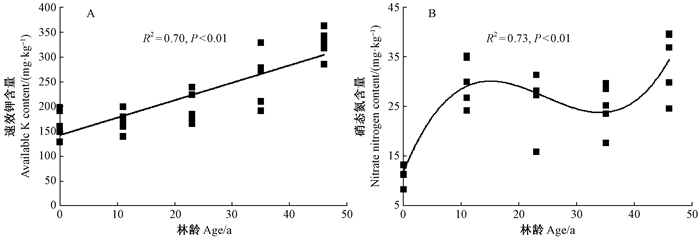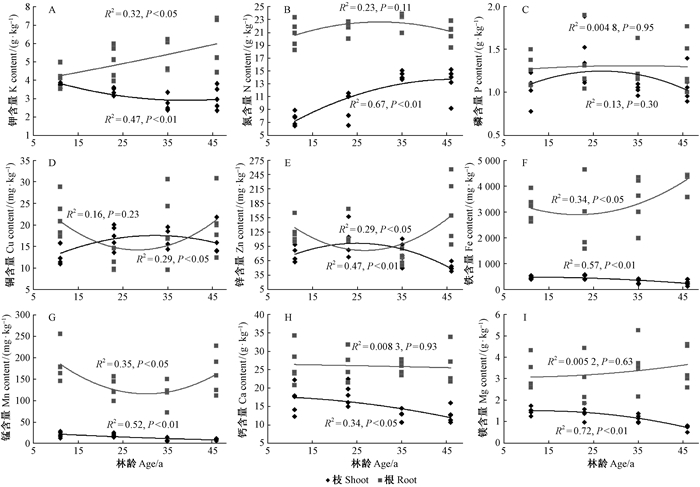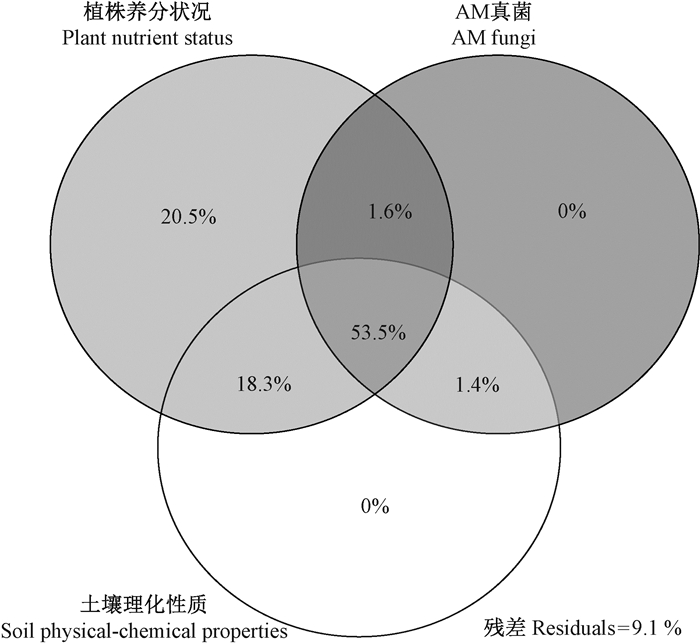文章信息
- 陈雪冬, 唐明, 张新璐, 周远博, 韦素贞, 盛敏
- Chen Xuedong, Tang Ming, Zhang Xinlu, Zhou Yuanbo, Wei Suzhen, Sheng Min
- 黄土高原刺槐纯林的土壤-菌根关系及随林龄的变化
- Variation of the Relationships between Arbuscular Mycorrhizal Fungi and Soil Properties with Different Stand Age of Robinia pseudoacacia Plantations on the Loess Plateau
- 林业科学, 2017, 53(12): 84-92.
- Scientia Silvae Sinicae, 2017, 53(12): 84-92.
- DOI: 10.11707/j.1001-7488.20171209
-
文章历史
- 收稿日期:2016-12-13
- 修回日期:2017-09-21
-
作者相关文章
2. 西北农林科技大学林学院 杨凌 712100;
3. 威海海洋职业学院食品工程系 荣成 264300
2. College of Forestry, Northwest A & F University Yangling 712100;
3. Department of Food Engineering, Weihai Ocean Vocational College Rongcheng 264300
黄土高原是我国水土流失最严重的地区之一,为改善生态环境、防治土壤侵蚀,在黄土高原营建了大面积水土保持植被(Yuan et al., 2015)。其中,刺槐(Robinia pseudoacacia)是主要造林树种之一,其适应性强、生长快,在防风固沙、保持水土和涵养水源等方面均发挥了一定作用(王迪海等, 2010)。然而,近年来的一些研究发现,刺槐纯林已表现出土壤性质改变、群落衰退、生产力降低等诸多问题,且随林龄增加而加剧,严重限制了人工刺槐林可持续经营和生态效益发挥(刘增文等, 2009; Qiu et al., 2010)。
已有研究表明,黄土高原人工刺槐纯林生态效益降低的主要原因是随林龄增加其生物学特性发生了变化(如叶片结构、光合速率及光面积等)(李俊辉等, 2012),但其变化原因及与刺槐生长状况间的关系尚不明确。丛枝菌根(arbuscular mycorrhiza, AM)真菌是重要的土壤生物成员之一(Kivlin et al., 2011; Pozo et al., 2013),是连接地上和地下生态系统物质传输的桥梁,在帮助植物吸收水分和养分、改善植物营养代谢和促进植物生长发育等方面发挥着重要作用(Castillo et al., 2006; Bücking et al., 2015; Berruti et al., 2016)。目前研究发现AM真菌与黄土高原不同林龄刺槐根系均能形成典型的泡囊丛枝结构(杜小刚等, 2008; 封晔等, 2012),但该共生结构与不同林龄刺槐生长状况间的关系尚不完全清楚。因此,笔者选取陕西省长武县王东沟流域的草地(0年)和11、23、35和46年生刺槐纯林,分析不同林龄刺槐生长状况、根和枝中的养分含量、土壤理化性质及根中AM真菌的共生状况,揭示“菌根-刺槐-土壤”三者之间的内在联系,明确不同林龄刺槐生长状况的关键影响因子。研究结果可为黄土高原人工刺槐纯林的经营管理提供依据。
1 材料与方法 1.1 研究区概况研究区位于陕西省长武县中国科学院长武农业生态试验站的王东沟流域(35°12′N,107°40′E),该流域地处黄土高原丘陵沟壑区,属暖温带半湿润大陆性季风气候,年均降水量584 mm,年均气温9.1 ℃,无霜期平均171天(Dang et al., 2006)。土壤类型为黑垆土,母质为深厚的中壤质马兰黄土。自20世纪50年代开始大规模造林,现已形成了不同年限的人工刺槐纯林,并通过禁牧、禁伐和防火等措施进行了有效保护(Qiu et al., 2010)。
1.2 样品采集2013年11月,采用时空互代法,选择营造和管理方法一致、坡向坡位相似的草地(0年)和11、23、35和46年生的人工刺槐纯林样地(表 1),每个样地设置5个20 m × 20 m的样方。在每个草地样方中,采用“S”形布点法在0~20 cm土层采集土样约1 kg。在每个刺槐纯林样方中,随机选择刺槐5株,分别测定其株高和胸径,并于每个植株树冠顶端的第一分枝剪取适量枝条,混合后作为该样方的代表性枝样;每株刺槐地面按东西南北4个方位,去除枯枝落叶层后,在0~20 cm土层范围内沿植物主根系采集带有细根的根系,轻轻抖落附在根上的土壤后在无菌自封袋中剧烈抖动1 min,收集根际土,分别混合根及根际土后作为该样方的代表性根样和土样。将采集的根际土部分风干后连同剩余的鲜土及全部植物样品保存于-20 ℃的冰箱中备用。
|
|
采用重铬酸钾容量法测定土壤有机质含量(Nelson et al., 1982),采用碳酸氢钠-钼锑抗比色法测定速效磷含量(Olsen et al., 1982),采用火焰原子吸收光谱法测定速效钾、铜、锌、铁、锰、钙和镁含量(Jorhem, 2000),采用AA3连续流动分析仪测定土壤硝态氮含量(陈云增等, 2016)。
采用Wright等(1996)的方法,测定易提取球囊霉素的含量。
1.3.2 AM真菌侵染率和孢子密度的测定根系样品采用透明压片法制片,镜检丛枝、泡囊和菌丝等结构特征(Phillings et al., 1970),并用十字交叉法计算菌根侵染率(McGonigle et al., 1990)。
| $ 菌根侵染率(\%)=观察到菌根结构的交叉点数/总交叉点数×100\%。$ | (1) |
分别从各土样中取100 g风干土2份;一份在105 ℃下烘干至恒质量,即为土壤干质量;另一份用湿筛倾析法分离孢子,在解剖镜下记录孢子总数;然后利用公式(2)计算AM真菌的孢子密度(弓明钦等, 1997)。
| $ 孢子密度(个 \cdot \rm{g}^{-1}干土)=孢子总数/土壤干质量。$ | (2) |
将采集的刺槐枝和根烘干研磨后,过1.0 mm和0.5 mm孔径的筛,室温下保存备用。分别称取0.2 g过0.5 mm筛的枝和根样,用浓硫酸矿化后分别采用凯氏定氮法、钼锑抗比色法和火焰光度计法测定氮、磷和钾的含量(鲍士旦, 2000)。分别称取1.0 g过1.0 mm筛的枝和根样,在525~550 ℃下灰化后,采用火焰原子吸收光谱法测定铜、锌、铁、锰、钙和镁的含量(Jorhem, 2000)。
1.4 统计分析采用R语言的Vegan程序包对试验数据进行统计分析(Oksanen et al., 2013)。
2 结果与分析 2.1 土壤理化性质随林龄的变化采用Vegan程序包中的adonis()函数分析,结果表明,土壤性质随林龄增加发生了显著变化(Pseudo-F=21.08, P<0.01)。主成分分析结果进一步表明,第一主成分草地的土壤理化性质与刺槐纯林显著不同,46年与11、23年生刺槐林地显著不同,而35年生与11、23和46年生刺槐林地均无显著差异(图 1)。回归分析结果表明,林龄变化与速效钾及硝态氮含量有显著相关性。其中,速效钾含量随林龄增加而增加,硝态氮含量随林龄增加呈先升后降再升高的趋势(图 2)。

|
图 1 不同林龄刺槐林地土壤理化性质的主成分分析 Figure 1 Principal component analysis (PCA) of soil physic-chemical properties in black locust plantations with different stand age 不同字母表示在P<0.05水平下差异显著。 Different letters show significant differences at P < 0.05 level. |

|
图 2 刺槐林地土壤中速效钾和硝态氮含量随林龄的变化 Figure 2 Changes of soil available K and nitrate nitrogen contents with black locust stand age |
回归分析表明,AM真菌侵染率在林龄小于35年时随林龄增加而增加,大于35年时基本维持恒定(图 3A)。随刺槐林龄增加,AM真菌孢子密度呈直线上升趋势,而土壤中易提取球囊霉素的含量则呈直线下降趋势(图 3B、C)。

|
图 3 AM真菌侵染率、孢子密度及土壤中易提取球囊霉素含量随林龄的变化 Figure 3 Changes of AM fungal colonization rate, spore density and easily extractable glomalin content in soil with stand age |
采用Vegan程序包中的adonis()函数分析,结果表明,刺槐根(Pseudo-F=16.38, P<0.01)和枝(Pseudo-F=3.97, P<0.05)中养分状况随林龄发生了显著变化。回归分析表明,根中钾含量随林龄增加而增加,锌、铁和锰含量随林龄增加而呈先减后增的趋势,而氮、磷、铜、钙和镁含量与林龄无显著(P > 0.05)相关(图 4)。与根中各养分含量变化趋势不同,随刺槐林龄增加,枝中氮含量上升,铜和锌含量先增加后降低,钾、铁、锰、钙和镁含量缓慢降低,而磷含量与林龄变化无显著(P > 0.05)相关(图 4)。

|
图 4 刺槐根和枝中养分含量随林龄的变化 Figure 4 Changes of nutrient contents in black locust shoots and roots with stand age |
选取与刺槐林龄有关的土壤、AM真菌及植株养分指标进行相关分析,结果表明,AM真菌孢子密度与土壤中速效钾含量呈显著正相关(r=0.75, P < 0.05),易提取球囊霉素含量与土壤中硝态氮含量呈显著负相关(r=-0.52, P < 0.05),而植株养分含量(枝中氮、钾、铁、锰、钙和镁及根中钾、锌、铁和锰)与土壤中硝态氮和速效钾含量、AM真菌侵染率和孢子密度均密切相关(图 5)。

|
图 5 土壤理化性质、AM真菌及刺槐植株养分状况间的关系网络 Figure 5 Networks of correlations among soil physical-chemical properties, AM fungi and black locust nutrient status 节点表示各土壤理化性质、AM真菌及刺槐植株养分指标;连线表示两端节点具显著相关性(P < 0.05);连线上数值为Pearson相关系数。The nodes represent soil, plant and AM fungal parameters, the edge represent a significant (P < 0.05) relationship between the nodes, and the number on each edge are the Pearson’s correlation coefficient. |
选择与刺槐林龄有关的土壤、AM真菌及植株养分指标为解释变量,利用varpart()变差分析函数比较土壤理化性质、AM真菌及植株养分状况对刺槐生长的贡献程度。结果表明,土壤理化性质、AM真菌和植株养分状况共解释90.9%的变差,其中53.5%的变差为三者共同解释,这可能表明土壤理化性质、AM真菌和植株养分状况是相互依赖、共同影响了刺槐的生长(图 6)。

|
图 6 土壤理化性质、AM真菌及植株养分状况对刺槐生长状况影响的变差分析 Figure 6 Variation partitioning of black locust growth by soil physical-chemical properties, AM fungal attributes and plant nutrient status |
冗余度分析结果表明,与刺槐生长状况表现为正相关的影响因子随林龄的变化不同。其中,11年生刺槐的生长状况主要与枝中钾、锰、钙、镁和铁含量呈正相关;23年生刺槐主要与枝中铁和锌含量呈正相关;35年生刺槐主要与枝中氮和铜含量、土壤速效钾含量、AM真菌侵染率和孢子密度呈正相关;46年生刺槐主要与根中钾和铁含量、AM真菌孢子密度、土壤速效钾和硝态氮含量呈正相关(图 7)。

|
图 7 不同林龄刺槐生长状况影响因子RDA排序图 Figure 7 Redundancy analysis diagram of the different-aged black locust growth and environmental factors |
本研究发现各土壤因子中以硝态氮和速效钾含量随林龄的变化最为显著。刺槐作为一种固氮树种,可将大气中的分子态N2转化为植物可利用的化合态N(NH4+和NO3-),可在一定程度上增加土壤中氮的储量(Rice et al., 2004; Jin et al., 2016)。值得关注的是本研究发现土壤中硝态氮含量随林龄的增加呈先升后降再升高的趋势,而非呈一直上升的趋势。这可能是因为中幼龄(<23年)刺槐生长旺盛,代谢活跃,固氮能力强,导致氮素在土壤中快速累积;随林龄的增加(23~35年),刺槐生物量增大,其所固定的氮素基本都用于其自身生长,为土壤中提供氮素的能力逐渐下降;然而随林龄的进一步增加(> 35年),其林下凋落物增多,此时土壤中微生物及根系分泌物可将凋落物中的有机氮逐渐分解为无机氮,导致土壤中速效氮含量有所回升(Wang et al., 2012)。
许明祥等(2004)研究发现刺槐纯林的林龄每增加10年其林下土壤速效钾的含量就有显著增加,本研究也证实刺槐纯林地土壤中速效钾含量随林龄的增大而增加。究其原因可能是因为随刺槐造林年限的增加,其林下土壤微生物及根系分泌物增多,促进了难溶的矿物态钾向水溶性及交换性钾的转化(张社奇等, 2008)。
3.2 AM真菌侵染状况及球囊霉素含量随林龄的变化本研究发现AM真菌侵染率随林龄的增加呈先增加后维持稳定的趋势,但这一变化与土壤因子无关。对刺槐而言,随林龄的增加其侧根和须根数量逐渐增多,侧根和须根的增多为AM真菌提供更多的侵染位点,AM真菌侵染率会随林龄的增加而上升,但这一上升趋势会在林龄大于35年后逐渐趋于平稳,究其原因可能是随刺槐林龄的增加其根表细胞间隙缩小,AM真菌进入表层阻力加大,降低了AM真菌对根系的侵染能力(刘振坤等, 2013)。与侵染率不同,AM真菌孢子密度随刺槐林龄的增加而增加,且孢子密度与土壤中速效钾含量呈显著正相关,说明菌根侵染率与孢子密度间并无严格的对应关系,且其影响因素也存在一定的差异。
球囊霉素对维持土壤有机碳平衡和土壤团聚体稳定性具有明显作用(唐宏亮等, 2009)。本研究发现黄土高原刺槐纯林地土壤中易提取球囊霉素含量与刺槐林龄呈显著负相关。多数研究认为球囊霉素含量与AM真菌关系密切(陈颖等, 2009; Koide et al., 2013)。然而本研究却发现球囊霉素含量与土壤中硝态氮含量呈显著负相关,而与AM真菌侵染率和孢子密度无显著相关性。
3.3 刺槐养分状况随林龄的变化对于植株地上部,Li等(2013)研究发现当刺槐林龄小于20年时其枝中氮和钾含量与林龄无关,而本研究发现当刺槐林龄为11~46年时其枝中氮含量随林龄的增加而增加,钾含量则随林龄的增加而降低。除此之外,本研究还发现植物生长所需微量元素(铜、锌、铁、锰、钙和镁)的含量基本都随林龄的增加(尤其是在林龄大于23年后)而有所降低。对于植株地下部,本研究发现刺槐根中钾含量随林龄(11~46年)的增加而增加,而李靖等(2013)研究认为刺槐根中钾含量与林龄(0~20年)无关,导致这一差异的主要原因可能与选择的刺槐林龄段及生长环境有关。关于根中的微量元素,本研究发现锌、铁和锰含量随刺槐林龄的增加而呈先降后升的趋势,在林龄为23年时达最低值。至于刺槐养分状况随林龄变化的原因,本研究发现刺槐养分含量与土壤硝态氮、速效钾、AM真菌侵染程度等密切相关,推测可能受其综合作用的影响。
3.4 不同林龄刺槐生长状况的影响因素本研究发现黄土高原人工刺槐纯林生长状况的影响因子也与林龄有关。具体而言,11年生刺槐林光合能力强,各器官生长代谢活跃,可以高效地利用自身养分来满足其生长需求;23年生刺槐正处于干材发育快速阶段,林分密度增加,种内竞争激烈,自身养分仍然是限制其生长的主要因素;刺槐生长35年后,AM真菌侵染率高,土壤中具有丰富的外延菌丝网,可以帮助植物吸收水分和营养物质(Grunwald et al., 2009; Smith et al., 2011),同时该林龄刺槐根系发达,吸收面积大,林下土壤中氮、钾累积量大,这可能是该林龄刺槐对地下部养分状况、AM真菌、土壤中氮和钾素依赖性增强的主要原因(张昌顺等, 2005)。
4 结论黄土高原刺槐纯林地土壤理化性质、AM真菌侵染状况及植株养分含量随林龄的增加而显著变化,且这些因素的变化与刺槐的生长状况密切相关。其中,中幼龄(11~23年生)刺槐林的生长状况主要依赖于地上部养分状况,而成熟(35~46年生)刺槐林则受植株地上和地下部养分状况、AM真菌及土壤中氮、钾储量等因素的综合影响,但其影响机理尚不明确,有待进一步研究。
鲍士旦. 2000. 土壤农化分析[M]. 北京: 中国农业出版社. (Bao S D. 2000. Soil agro-chemistrical analysis[M]. Beijing: China Agriculture Press. [in Chinese]) |
陈颖, 贺学礼, 山宝琴, 等. 2009. 荒漠油蒿根围AM真菌与球囊霉素的时空分布[J]. 生态学报, 29(11): 6010-6016. (Chen Y, He X L, Shan B Q, et al. 2009. The spatio-temporal distribution of arbuscular mycorrhiza fungi and glomalin in the rhizosphere of Artemisia ordosica in desert[J]. Acta Ecologica Sinica, 29(11): 6010-6016. DOI:10.3321/j.issn:1000-0933.2009.11.032 [in Chinese]) |
陈云增, 陈志凡, 马建华, 等. 2016. 沙颍河流域典型癌病高发区土壤硝态氮对地下水和蔬菜硝酸盐积累的影响[J]. 环境科学学报, 36(3): 990-998. (Chen Y Z, Chen Z F, Ma J H, et al. 2016. Effects of soil nitrate nitrogen on the nitrate accumulation in groundwater and vegetables in a typical high cancer incidence area of Shaying River basin[J]. Acta Scientiae Circumstantiae, 36(3): 990-998. [in Chinese]) |
杜小刚, 唐明, 陈辉, 等. 2008. 黄土高原不同林龄刺槐丛枝菌根与根际微生物的群落多样性[J]. 林业科学, 44(4): 78-82. (Du X G, Tang M, Chen H, et al. 2008. Mycorrhizae and diversity of microbial community in rhizosphere soils of Robinia pseudoacacia at different ages on the Loess Plateau[J]. Scientia Silvae Sinicae, 44(4): 78-82. DOI:10.11707/j.1001-7488.20080414 [in Chinese]) |
封晔, 唐明, 陈辉, 等. 2012. 黄土高原六道沟流域8种植物根际细菌与AMF群落多样性研究[J]. 环境科学, 33(1): 314-322. (Feng Y, Tang M, Chen H, et al. 2012. Community diversity of bacteria and arbuscular mycorrhizal fungi in the rhizosphere of eight plants in Liudaogou watershed on the Loess Plateau China[J]. Environmental Science, 33(1): 314-322. [in Chinese]) |
弓明钦, 陈应龙, 仲崇禄. 1997. 菌根研究及应用[M]. 北京: 中国林业出版社. (Gong M Q, Chen Y L, Zhong C L. 1997. Mycorrhizal research and application[M]. Beijing: China Forestry Publishing House. [in Chinese]) |
李靖, 马永禄, 罗杰, 等. 2013. 黄土丘陵沟壑区不同林龄刺槐林养分特征与生物量研究[J]. 西北林学院学报, 28(3): 7-12. (Li J, Ma Y L, Luo J, et al. 2013. Nutrients and biomass of different-aged Robinia pseudoacacia plantations in the Loess hilly region[J]. Journal of Northwest Forestry University, 28(3): 7-12. [in Chinese]) |
李俊辉, 李秧秧. 2012. 立地条件和林龄对刺槐叶形态及生理特性的影响[J]. 水土保持学报, 19(4): 176-181. (Li J H, Li Y Y. 2012. Effects of site and tree age on leaf morpho-physiological traits of black locust[J]. Research of Soil and Water Conservation, 19(4): 176-181. [in Chinese]) |
刘增文, 段而军, 冯顺煜. 2009. 黄土高原半干旱丘陵区不同树种纯林土壤性质极化研究[J]. 土壤学报, 46(6): 1110-1120. (Liu Z W, Duan E J, Feng S Y. 2009. Soil polarization under pure stands of different tree varieties in semi-arid hilly areas of the Loess Plateau[J]. Acta Pedologica Sinica, 46(6): 1110-1120. DOI:10.11766/200812190620 [in Chinese]) |
刘振坤, 田帅, 唐明. 2013. 不同林龄刺槐林丛枝菌根真菌的空间分布及与根际土壤因子的关系[J]. 林业科学, 49(8): 89-95. (Liu Z K, Tian S, Tang M. 2013. Spatial distribution of arbuscular mycorrhizal fungi and its relationship with soil factors in the rhizophere of Robinia pseudoacacia at different ages[J]. Scientia Silvae Sinicae, 49(8): 89-95. DOI:10.11707/j.1001-7488.20130813 [in Chinese]) |
唐宏亮, 刘龙, 王莉, 等. 2009. 土地利用方式对球囊霉素土层分布的影响[J]. 中国生态农业学报, 17(6): 1137-1142. (Tang H L, Liu L, Wang L, et al. 2009. Effect of land use type on profile distribution of glomalin[J]. Chinese Journal of Eco-Agriculture, 17(6): 1137-1142. [in Chinese]) |
王迪海, 赵忠, 李剑. 2010. 黄土高原不同气候区刺槐细根表面积的差异[J]. 林业科学, 46(5): 70-76. (Wang D H, Zhao Z, Li J. 2010. Difference of surface area of fine roots of Robinia pseudoacacia in the different climate regions of Loess Plateau[J]. Scientia Silvae Sinicae, 46(5): 70-76. DOI:10.11707/j.1001-7488.20100512 [in Chinese]) |
许明祥, 刘国彬. 2004. 黄土丘陵区刺槐人工林土壤养分特征及演变[J]. 植物营养与肥料学报, 10(1): 40-46. (Xu M X, Liu G B. 2004. The characteristics and evolution of soil nutrient in artificial black locust (Robinia pseudoacacia) forest land in the hilly Loess Plateau[J]. Plant Nutrition and Fertilizing Science, 10(1): 40-46. DOI:10.11674/zwyf.2004.0108 [in Chinese]) |
张昌顺, 李昆. 2005. 人工林养分循环研究现状与进展[J]. 世界林业研究, 18(4): 35-39. (Zhang C S, Li K. 2005. Research status and advances of nutrient cycling of plantation[J]. World Forestry Research, 18(4): 35-39. [in Chinese]) |
张社奇, 王国栋, 张蕾. 2008. 黄土高原刺槐林对土壤养分时空分布的影响[J]. 水土保持学报, 22(5): 91-95. (Zhang S Q, Wang G D, Zhang L. 2008. Time-space distributive feature of soil nutrient and chemical characteristics of Robinia pseudoacacia L. plantation forestland in Loess Plateau[J]. Journal of Soil and Water Conservation, 22(5): 91-95. [in Chinese]) |
AOAC (Association of Official Agricultural Chemists). 1990. Official Methods of Analysis, 16th ed. Association of Analytical Chemists, Washington, DC.
|
Berruti A, Lumini E, Balestrini R, et al. 2016. Arbuscular mycorrhizal fungi as natural biofertilizers:Let's benefit from past successes[J]. Frontiers in Microbiology, 6: 1559. |
Bücking H, Kafle A. 2015. Role of arbuscular mycorrhizal fungi in the nitrogen uptake of plants:current knowledge and research gaps[J]. Agronomy, 5(4): 587-612. DOI:10.3390/agronomy5040587 |
Castillo P, Nico A I, Azcón-Aguilar C, et al. 2006. Protection of olive planting stocks against parasitism of root-knot nematodes by arbuscular mycorrhizal fungi[J]. Plant Pathology, 55(5): 705-713. DOI:10.1111/ppa.2006.55.issue-5 |
Dang T H, Cai G X, Guo S L, et al. 2006. Effect of nitrogen management on yield and water use efficiency of rainfed wheat and maize in Northwest China[J]. Pedosphere, 16(4): 495-504. DOI:10.1016/S1002-0160(06)60080-5 |
Grunwald U, Guo W, Fischer K, et al. 2009. Overlapping expression patterns and differential transcript levels of phosphate transporter genes in arbuscular mycorrhizal, Pi-fertilised and phytohormone-treated Medicago truncatula roots[J]. Planta, 229(5): 1023-1034. DOI:10.1007/s00425-008-0877-z |
Jin Z, Li X, Wang Y, et al. 2016. Comparing watershed black locust afforestation and natural revegetation impacts on soil nitrogen on the Loess Plateau of China[J]. Scientific Reports, 6: 25048. DOI:10.1038/srep25048 |
Jorhem L. 2000. Determination of metals in foods by atomic absorption spectrometry after dry ashing:NMKL1 collaborative study[J]. Journal of AOAC International, 83(5): 1204-1211. |
Kivlin S N, Hawkes C V, Treseder K K. 2011. Global diversity and distribution of arbuscular mycorrhizal fungi[J]. Soil Biology and Biochemistry, 43(11): 2294-2303. DOI:10.1016/j.soilbio.2011.07.012 |
Koide R T, Peoples M S. 2013. Behavior of Bradford-reactive substances is consistent with predictions for glomalin[J]. Applied Soil Ecology, 63: 8-14. DOI:10.1016/j.apsoil.2012.09.015 |
Li H, Li J, He Y, et al. 2013. Changes in carbon, nutrients and stoichiometric relations under different soil depths, plant tissues and ages in black locust plantations[J]. Acta Physiologiae Plantarum, 35(10): 2951-2964. DOI:10.1007/s11738-013-1326-6 |
McGonigle T P, Miller M H, Evans D G, et al. 1990. A new method which gives an objective measure of colonization of roots by vesicular-arbuscular mycorrihizal fungi[J]. New Phytologist, 115: 495-501. DOI:10.1111/nph.1990.115.issue-3 |
Nelson D W, Sommers L E. 1982. Total carbon, organic carbon and organic matter//Page A L. Methods of Soil Analysis:Part 2, Agronomy Monograph 9. 2nd ed. American Society of Agronomy and Soil Science Society of America, Madison, 539-579.
|
Oksanen J, Blanchet G F, Kindt R, et al. 2013. Vegan:Community Ecology Package. R Package Version 2.0-10[2016-10-25]. http://CRAN.R-project.org/package=vegan.
|
Olsen S R, Sommers L E, Page A L. 1982. Phosphorus//Methods of Soil Analysis. Part 2. Chemical and Microbiological Properties of Agronomy Monograph, 9, ASA, 403-430.
|
Phillips J M, Hayman D S. 1970. Improved procedures for clearing roots and staining parasitic and vesicular-arbuscular mycorrhizal fungi for rapid assessment of infection[J]. Transactions of the British Mycological Society, 55(1): 158-IN18. DOI:10.1016/S0007-1536(70)80110-3 |
Pozo M J, Jung S C, Martınez-Medina A, et al. 2013. Root allies:arbuscular mycorrhizal fungi help plants to cope with biotic stresses//Aroca R. Symbiotic Endophytes. Springer, Berlin, Heidelberg, 37, 289-307.
|
Qiu L, Zhang X, Cheng J, et al. 2010. Effects of black locust (Robinia pseudoacacia) on soil properties in the loessial gully region of the Loess Plateau, China[J]. Plant and Soil, 332(1/2): 207-217. |
Rice S, Westerman B, Federici R. 2004. Impacts of the exotic, nitrogen-fixing black locust (Robinia pseudoacacia) on nitrogen-cycling in a pine-oak ecosystem[J]. Plant Ecology, 174(1): 97-107. DOI:10.1023/B:VEGE.0000046049.21900.5a |
Smith S E, Smith F A. 2011. Roles of arbuscular mycorrhizas in plant nutrition and growth:new paradigms from cellular to ecosystem scales[J]. Annual Review of Plant Biology, 62(1): 227-250. DOI:10.1146/annurev-arplant-042110-103846 |
Wang B, Liu G, Xue S. 2012. Effect of black locust (Robinia pseudoacacia) on soil chemical and microbiological properties in the eroded hilly area of China's Loess Plateau[J]. Environmental Earth Sciences, 65(3): 597-607. DOI:10.1007/s12665-011-1107-8 |
Wright S F, Upadhyaya A. 1996. Extraction of an abundant and unusual protein from soil and comparison with hyphal protein of arbuscular mycorrhizal fungi[J]. Soil Science, 161(9): 575-586. DOI:10.1097/00010694-199609000-00003 |
Yuan Z Q, Epstein H, Li F M. 2015. Factors affecting the recovery of abandoned semi-arid fields after legume introduction on the Loess Plateau[J]. Ecological Engineering, 79: 86-93. DOI:10.1016/j.ecoleng.2015.03.012 |
 2017, Vol. 53
2017, Vol. 53

